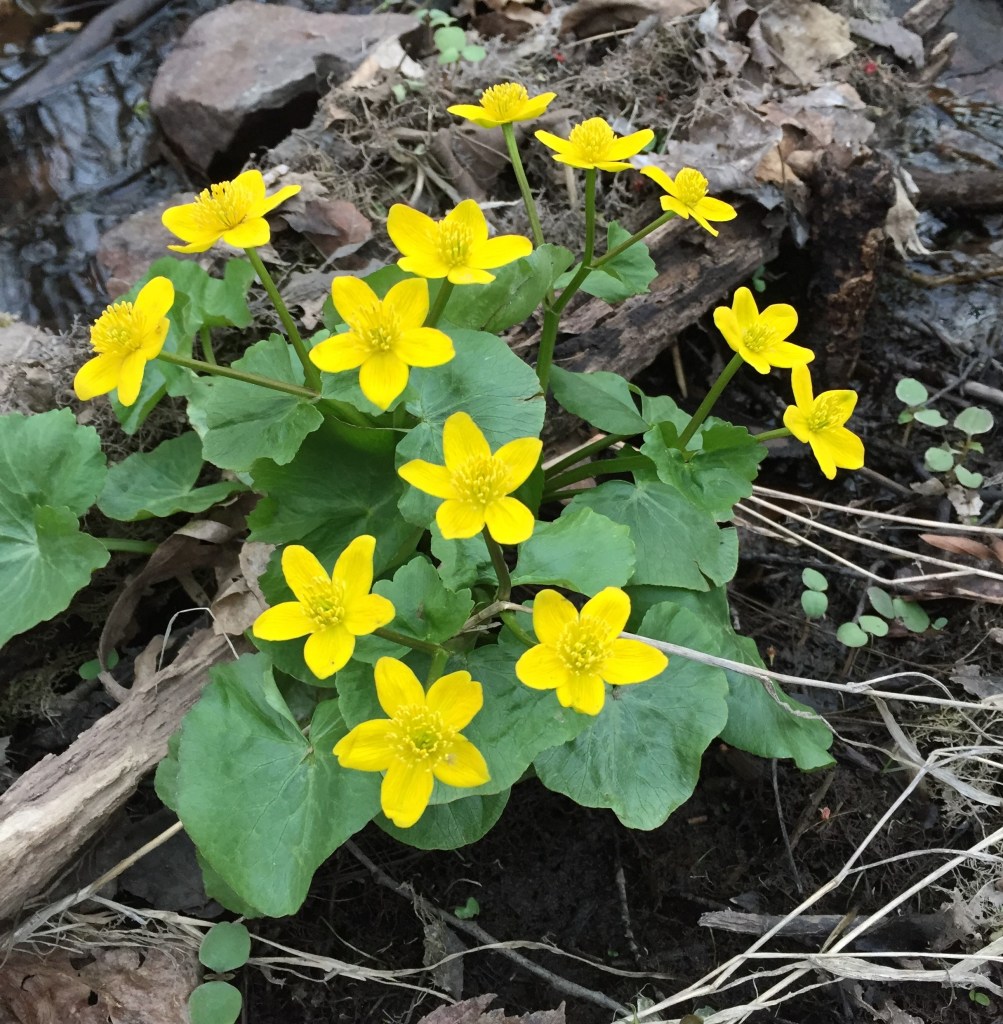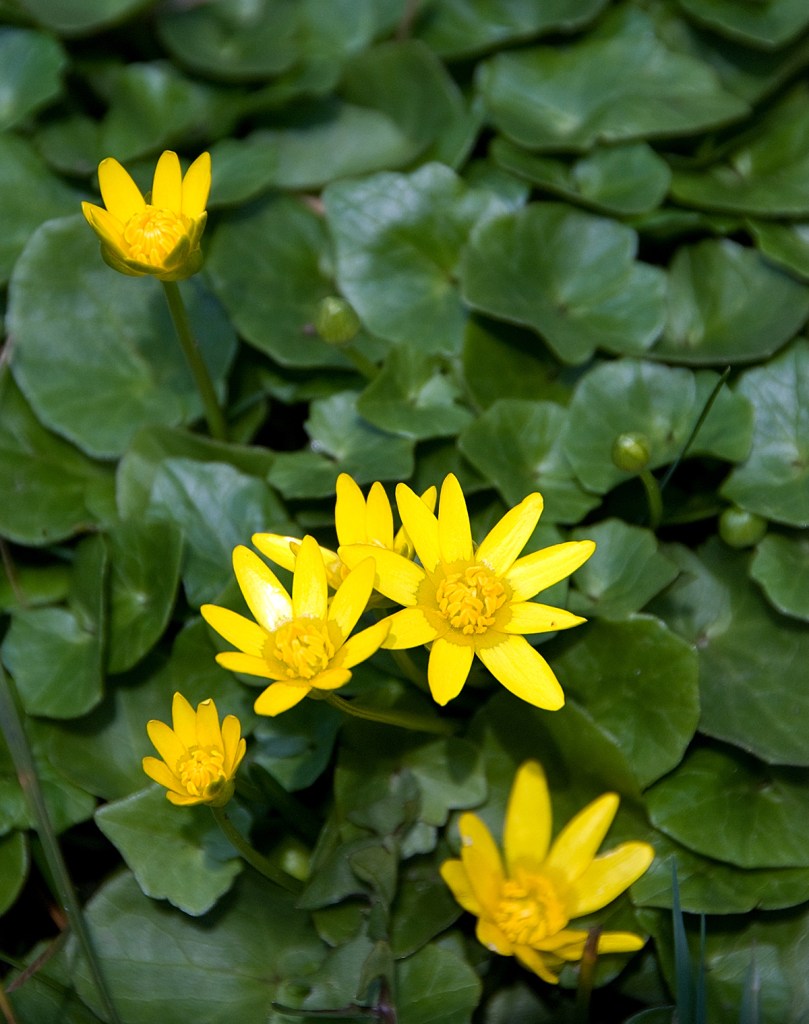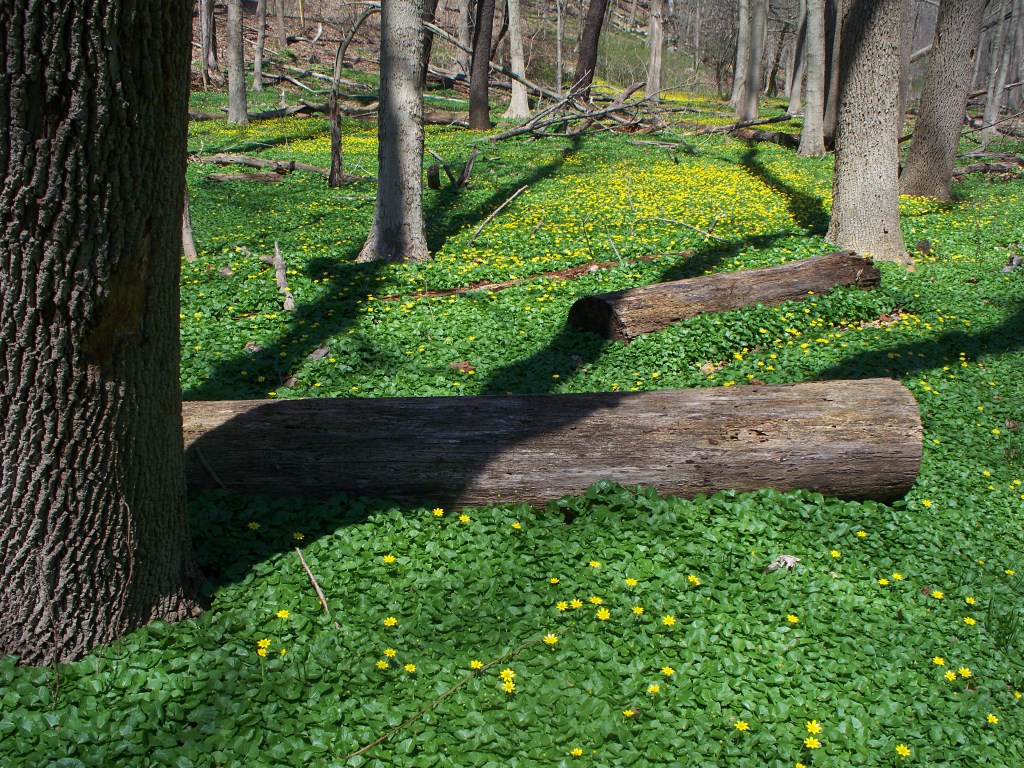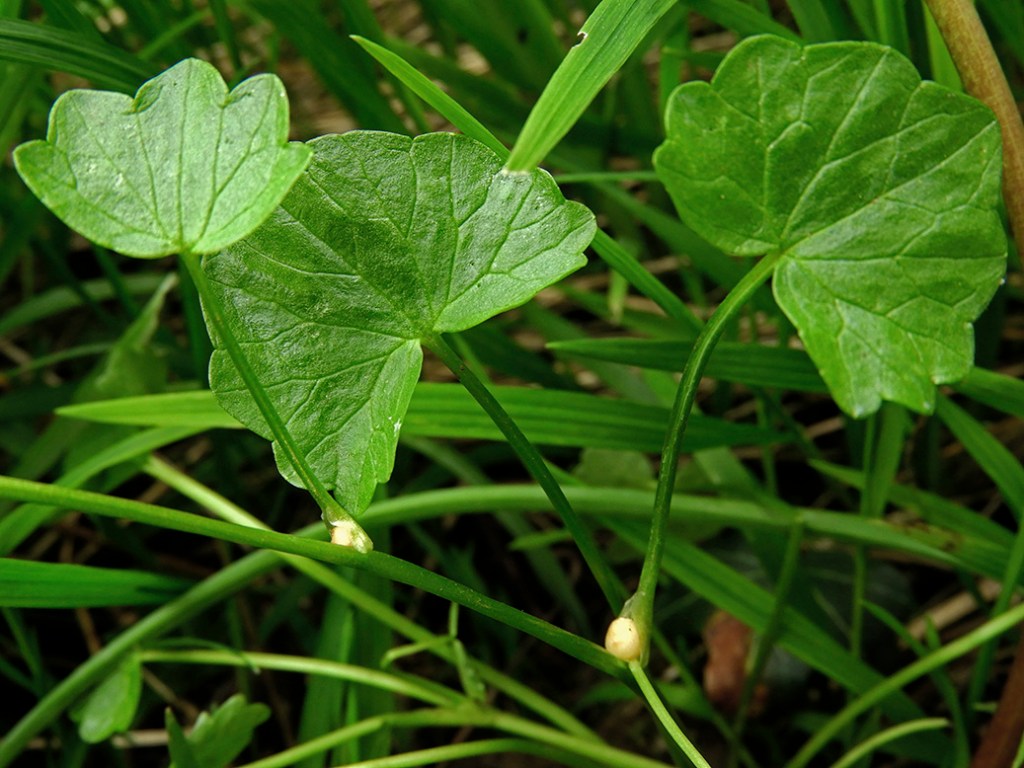I look forward each year to looking along streams to find one of my favorite spring wildflowers soon to be in bloom—Marsh Marigold (Caltha palustris). But it has an exotic cousin, a look-alike that threatens its existence and that of other native spring ephemerals such as Trout Lily (Erythronium americanum) and Spring Beauty (Claytonia virginica). It is Lesser Celandine (Ficaria verna).

Both Marsh Marigold and Lesser Celandine (also called Fig Buttercup, Pilewort, and Fig-crowfoot) are in the buttercup family, Ranunculaceae. They both have heart- or kidney-shaped leaves and yellow flowers.
So how do you tell them apart? Lesser Celandine’s leaves emerge really early in the spring, as early as February, and they are out now. When you are driving or hiking, look around to see what plants are in leaf. Many non-native invasives like Japanese Barberry (Berberis thunbergii) and Garlic Mustard (Alliaria petiolata) will leaf out before native plants, thereby outcompeting them for light. Check out stream and river banks and pond edges. Marsh Marigold is usually near the water’s edge. Lesser Celandine is more adaptable and can also be found in rich soils farther from water, even in sunny yards.

Lesser Celandine is a slightly smaller plant and flowers earlier than Marsh Marigold, usually in March or April here in Connecticut. If you see flowers on plants in late April to June, you can be almost certain it is Marsh Marigold. Marsh Marigold has 5 to 7 yellow tepals (undifferentiated petals or sepals), whereas Lesser Celandine has 7 to 11 yellow petals and 3 green sepals below the petals.
Invasive Lesser Celandine can form huge, extensive mats if left unchecked. The U.S. Department of Agriculture has predicted that it could establish itself in 79% of the continental United States. Now that’s an adaptable plant! It can do this because it forms tubers, which break off very easily through ground disturbance and flooding. After flowering, Lesser Celandine also forms bulbils in its leaf axils. This vegetative little bulb is a clone and can become a new plant.

How do you control this plant? If you have a small patch, try to eliminate it before it spreads into a monoculture. Control small patches by hand-digging the plant, making sure to sift out all tubers and throwing them in the trash. The tubers and roots are in the first 3 inches (about 8 centimeters) of the soil. Larger incursions are more difficult to control.

Marsh Marigold’s deep yellow flowers, larger than those of Lesser Celandine, are very striking near water. If you have a damp place in your yard in part to full sun, try growing it. It is sold at nurseries, particularly for plantings next to water or in rain gardens. Be sure to ask that the plants sold are nursery propagated.

Native plants like Marsh Marigold have spent thousands of years co-evolving with the pollinators in their ecosystem. Insects are co-evolved to feed on its leaves or gather its pollen and nectar. They in turn are fed on by birds. The nectar and pollen of the flowers of Marsh Marigold attract flies and bees, including the Giant Bee Fly (Bombylius major), syrphid flies, and halictid bees.
Yet, in a few decades, Marsh Marigold can be undone by non-native thugs like Lesser Celandine. By knowing the difference between the two and giving the native a chance to compete we can control the invasive and ensure a healthy ecosystem, even on a small scale like our own backyard or nearby streams.
I am very glad to read your warning about the invader that looks like Marsh Marigold but is so nasty. I have not yet noticed one of these invaders, but I will certainly be on the lookout and try to extra paid it. Thank you for the heads up.
LikeLike
Thanks Susanne. I appreciate you being on the lookout! Best, Jim
LikeLike
Thank you for this article on Lesser Celandine that looks a lot like Marsh Marigold. I will now be on the lookout for this invasive.
LikeLike
I really appreciate it Tracy, thanks! Jim
LikeLike
Hi Jim,
Thanks for clarifying the differences between Lesser celandine and Marsh marigold! It really helps to distinguish between the two plants while exploring a marshy area in the woods and spotting yellow plants blooming at this time of year. For a couple of years a Lesser celandine plant showed up in my vegetable garden (of all places!), but I removed it as you described and it hasn’t returned. It also seemed to me that the Lesser celandine flower is “shinier” than Marsh Marigold.
Hope you spot lots of Marsh marigold blooming in the woods this spring! We are enjoying some Hepatica and Cutleaf toothwort blooms at home, and waiting for the Trout lilies to appear. Spring is an exciting time!
Linda T.
LikeLike
Hi Linda, So glad you were able to get rid of it! Yes, it’s so great to see the spring ephemerals in bloom. My favorite time of year. All best, Jim
LikeLike
Lesser Celandine is galloping through my one acre yard in Branford, growing in size from clumps 6″ across to huge mats of 30 square feet plus. I did not have it at all 5 years ago, and now there is no way I’ll be able to control it. Herbicide is not an option; I live next to a salt marsh. Can’t dig it up, it is in with ivy. Most distressing!
LikeLike
Hi Elizabeth, Sorry you have such an invasion in your yard! You might try covering with two/three layers of wet cardboard followed by 4 inches of wood chips. You’ll have to sacrifice your English Ivy, which by the way can through time can invade an area as well.
LikeLike
Is there any way to eradicate lesser celandine other than cardboard & wood chips? I don’t use any pesticides. I have rid small patches by digging it up and collecting the little bulbs. But that is very time consuming and requires follow up.
LikeLike
Hi Druidlady, without using any chemicals ( which I am not an advocate of as well), those are the two methods I would recommend. Be sure to get all those little bulblets! Best, Jim
LikeLike
Do you think the CT Aggie extension service would have any other suggestions? Also, at this point is it advisable to wait till next spring or start eradication efforts now?
LikeLike
I think continue to do sift and remove the bulblets now is a good thing and will prevent spreading. Best, Jim
LikeLike
Thank you for your advice. I was hoping that there was a somewhat easier way to get rid of it since I’m a retiree!
LikeLike
Curious how you did.
LikeLike
Hi there, I luckily haven’t had to deal with Lesser Celandine in my yard. My recommendation would be to dig up the corms and get as many as you can. Then, cover the area with a few layers of wet cardboard and lastly 4 inches of wood chips. Best, Jim
LikeLike